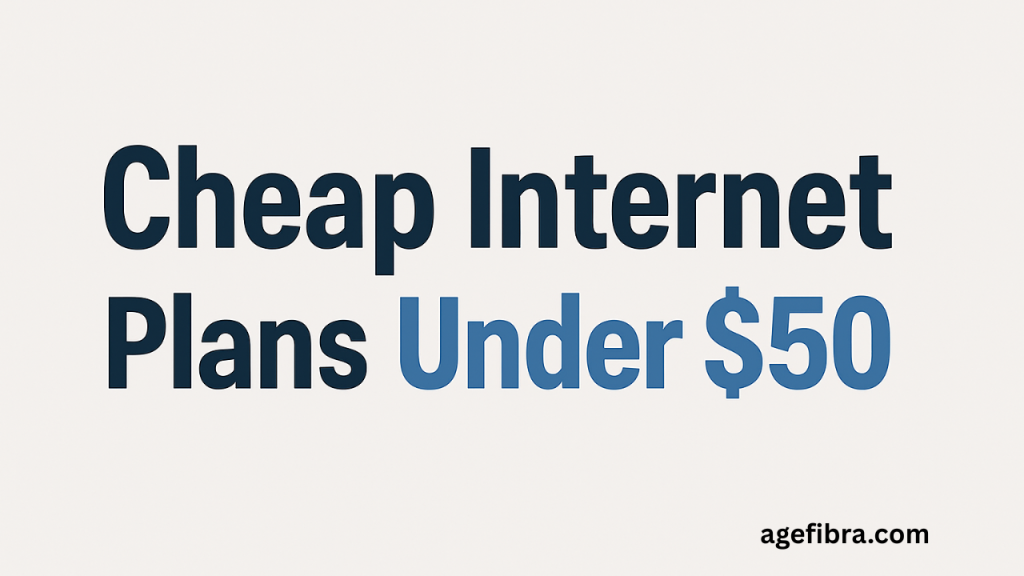In today’s connected world, staying online shouldn’t cost a fortune. Whether you’re working from home, attending virtual classes, streaming your favorite shows, or simply scrolling through social media, a solid internet connection has become a daily necessity. But many people assume that high-speed internet always comes with a high price tag. That’s not the case anymore. Cheap internet plans under $50 now offer dependable performance without long-term contracts or hidden fees. These budget-friendly options cater to students, small families, remote workers, and anyone who needs reliable access without breaking the bank.
Let’s explore some of the best affordable internet plans that combine low costs with solid speed and performance, so you can stay connected, productive, and entertained, all for less than $50 a month.
Why Cheap Internet Plans Are Gaining Popularity
Affordable internet isn’t just a convenience—it’s a necessity in a digital-first society. With inflation and rising utility costs, households are looking for ways to cut down on monthly expenses without compromising on quality. Cheap internet plans meet this need perfectly by offering reliable connectivity for typical daily usage like browsing, emailing, online meetings, and streaming.
Providers are becoming increasingly competitive, offering more value-packed packages to appeal to budget-conscious consumers. These plans also attract renters, students, digital nomads, and part-time remote workers who want flexibility and affordability in their connectivity options.
Best Cheap Internet Plans Under $50 in 2025
Several major internet service providers (ISPs) offer budget-friendly plans with decent download speeds, minimal data caps, and no credit check requirements. These plans vary based on region, but some widely available options include:
Xfinity Connect Plan
Xfinity’s entry-level plan offers up to 75 Mbps download speeds for just $30 to $45 per month. It’s a great fit for small households that stream content, attend Zoom calls, and browse the web. There’s no data cap on select packages, and installation is often free with online orders.
Spectrum Internet Assist
Priced at around $30 per month, Spectrum Internet Assist is designed for low-income households. It provides up to 100 Mbps speeds with no data caps or contracts. Eligibility requirements apply, but the reliability and speed are more than enough for everyday use.
AT&T Internet 100
AT&T’s fiber-powered Internet 100 plan comes in under $50 in some locations and offers up to 100 Mbps symmetrical speeds. It’s ideal for multi-user homes and remote work setups. This plan includes unlimited data, no annual contracts, and low latency for video calls or gaming.
T-Mobile 5G Home Internet
With a flat rate of $50 per month (taxes and fees included), T-Mobile’s 5G home internet plan delivers average speeds between 100-300 Mbps, depending on location. It’s a great cable alternative with no equipment fees and no data limits.
Frontier Fiber 100
Frontier’s Fiber 100 plan starts at around $40 to $50 per month and gives users up to 100 Mbps speeds. It’s a fiber-based option that supports smooth HD streaming, file uploads, and remote access. It’s particularly appealing in rural and suburban areas.
Read More: Top Prepaid Internet Plans with No Contracts or Credit Checks
What to Look for in a Cheap Internet Plan
Finding a good internet deal involves more than just looking at the price tag. You should also evaluate features that align with your household’s internet usage patterns.
Speed Tiers That Match Your Needs
Think about what you typically use the internet for. Light browsing and email require less than 25 Mbps, while HD streaming, gaming, or video conferencing might need 50 Mbps or higher. A family with multiple users should aim for 100 Mbps or more.
Data Caps and Throttling
Some cheap internet plans come with monthly data limits, while others offer unlimited data. Plans with throttling may reduce your speed after hitting a certain threshold. Always check for fair usage policies.
Equipment and Installation Costs
A low monthly rate is great, but watch out for extra fees like modem rentals or setup charges. Some ISPs include equipment for free, while others let you use your compatible router to save money.
Contract Terms and Cancellation Policies
Choose a plan with no annual contract if you want flexibility. Many cheap internet plans are month-to-month, which gives you the freedom to switch providers or move without early termination fees.
Step-by-Step Guide to Choosing the Right Budget Internet Plan
Step 1: Identify Your Usage Requirements
Determine your average data usage per month and the number of connected devices. If you mainly use the internet for Netflix, social media, and online shopping, you won’t need more than 50 Mbps. But if you work from home or have kids attending online classes, consider plans that offer 100 Mbps or more.
Step 2: Check Local Availability
Use provider websites or tools like BroadbandNow to compare what’s available in your area. Internet offerings can vary significantly depending on zip code, especially in rural zones.
Step 3: Compare Speed, Data, and Cost
Focus on value, not just price. A $45 plan with 100 Mbps and unlimited data is often better than a $35 plan with 30 Mbps and a 500 GB data cap.
Step 4: Consider Customer Service and Reliability
Look at online reviews, Better Business Bureau ratings, or ask your neighbors for feedback on reliability and downtime. A cheap plan isn’t helpful if it frequently drops or lags.
Step 5: Read the Fine Print
Before signing up, read the terms and conditions. Watch for hidden fees, promotional period limitations, or price hikes after 12 months.
Real-Life Use Cases: Who Benefits Most from Cheap Internet Plans
Students on a Budget
College students living off-campus often choose $30-$50 plans to stay within their tight budgets. These plans support video lectures, online research, and group chats without performance issues.
Remote Workers and Freelancers
For individuals working from home, a 100 Mbps plan under $50 allows seamless Zoom calls, cloud access, and file uploads. It’s also tax-deductible for self-employed professionals.
Small Households
Couples or families with 2–3 users can enjoy streaming, browsing, and smart home connectivity without needing ultra-fast gigabit internet.
Seniors and Retirees
Older adults who mainly use the internet for video calls with family or reading the news can rely on affordable plans under $40 for dependable service.
Tips to Get the Best Deal on Cheap Internet Plans
Negotiate with Your Provider
If you’re already using an internet service provider, don’t hesitate to call and ask for a better deal. Many ISPs offer loyalty discounts or limited-time promotions to retain existing customers. Simply mentioning that you’re considering switching can often unlock special pricing not advertised online.
Bundle Services When It Makes Sense
Bundling the internet with other services like mobile or TV can reduce your total monthly expenses. Some providers offer significant savings when you combine services. If you already use the same company for mobile or cable, ask about bundle options that fit within your $50 budget.
Use Your Router or Modem
Many providers charge a monthly rental fee for equipment, which can add $10 to $15 to your bill. Instead, consider purchasing a compatible router or modem. Over time, this one-time investment can lead to substantial savings.
Take Advantage of Special Discounts
Students, seniors, veterans, and low-income households may be eligible for exclusive discounts on internet service. These programs can bring your monthly bill well below the $50 mark. Always ask your provider about any available special pricing for your demographic.
Common Mistakes to Avoid
Overlooking Hidden Costs
The advertised price is not always the final amount you’ll pay. Installation fees, equipment rentals, taxes, and service charges can quickly inflate a $45 plan to $65 or more. Always ask for a full cost breakdown before signing up.
Falling for Promotional Pricing Traps
Many ISPs lure customers in with low introductory rates that increase significantly after 6 or 12 months. Be sure to read the fine print and ask what the regular rate will be once the promotional period ends. This helps you avoid unexpected spikes in your bill.
Paying for More Speed Than You Need
While having fast internet sounds appealing, you may not need 300 or 500 Mbps. For basic streaming, video calls, and browsing, 100 Mbps or even 50 Mbps is usually sufficient. Paying for unnecessary speed just adds to your monthly cost without tangible benefits.
Ignoring Data Caps and Throttling Policies
Some cheap internet plans have data usage limits. Once you exceed these limits, your speeds may be throttled, leading to frustratingly slow performance. Be sure to review the provider’s data policy, especially if your household does a lot of streaming or downloading.
Neglecting Upload Speed Requirements
Most people focus on download speed, but upload speed matters too, especially for video conferencing, cloud backup, and online gaming. If your plan offers great download rates but extremely low upload speeds, it could still result in poor performance during interactive activities.
Frequently Asked Questions
What is considered a cheap internet plan in 2025?
Any plan priced under $50 per month with at least 50 Mbps speed and stable service is considered cheap by industry standards.
Are cheap internet plans good for streaming Netflix or YouTube?
Yes, plans with speeds of 25 Mbps or more can handle HD streaming without buffering for single or dual-device households.
Do cheap internet plans come with unlimited data?
Some do. Plans from providers like T-Mobile, Spectrum, and AT&T often include unlimited data, even on their budget tiers.
Is fiber internet available in cheap plans?
Yes, several ISPs now offer fiber plans under $50 with 100 Mbps or higher speeds, especially in urban and suburban regions.
Can I work from home on a cheap internet plan?
Absolutely. Plans offering 50–100 Mbps can support video conferencing, cloud access, and screen sharing for remote work.
How do I avoid price hikes after the promo period?
Choose a provider that offers fixed pricing or negotiate a deal before the promo ends. Always confirm regular pricing upfront.
Are there government programs that help reduce internet bills?
Yes. The Affordable Connectivity Program (ACP) and other regional subsidies can lower your monthly bill by $30 or more for qualifying households.
Conclusion
Staying connected doesn’t have to drain your wallet. Cheap internet plans under $50 deliver exactly what most users need—reliable speeds, consistent service, and flexible terms. Whether you’re a student, remote worker, small household, or senior, there are affordable options tailored to your lifestyle and location. With a little research and careful comparison, you can find the perfect balance between cost and performance. Remember to evaluate speed, data, contract terms, and real-world reliability before locking in a plan. Making smart choices today can help you enjoy a seamless online experience without overspending every month. Cheap internet plans are no longer a compromise—they’re a smart decision.


